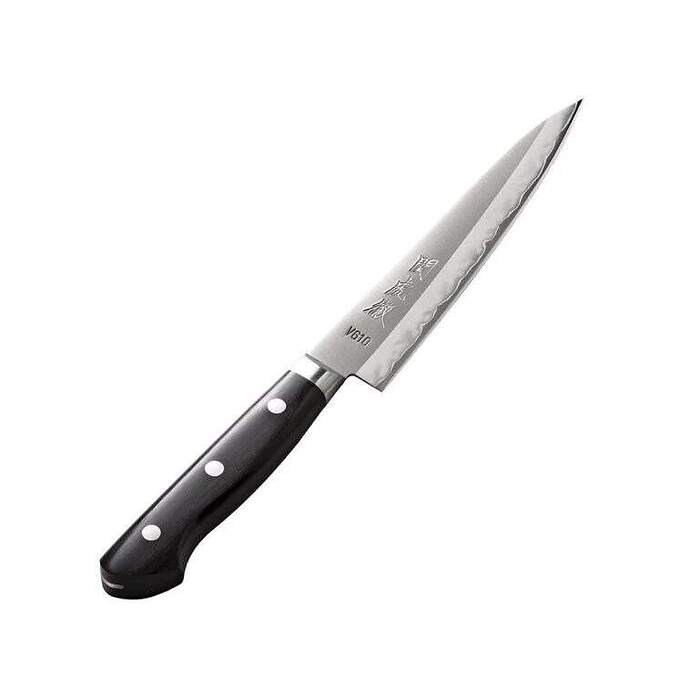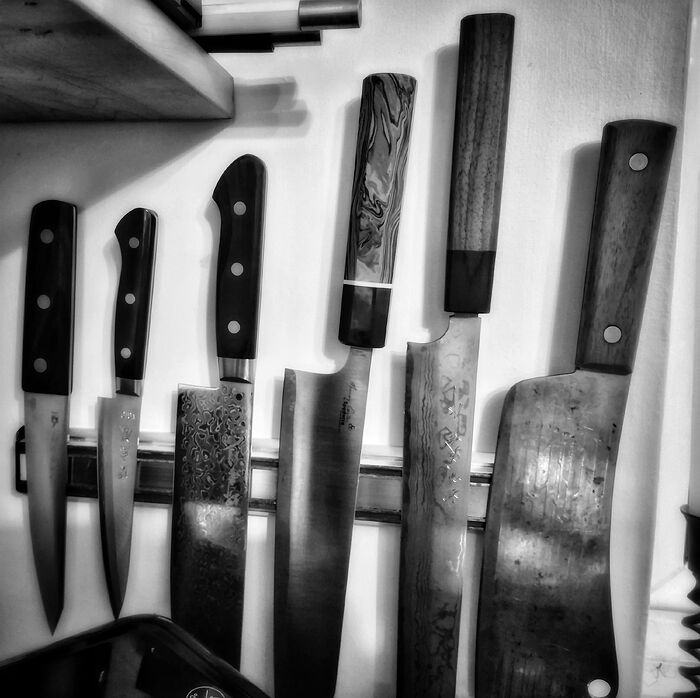If I follow…you are describing the logic that in theory a higher HRC number enables a knife with harder steel to hold a lower degree angle at the cutting edge with more durability than a softer steel which theoretically will fold. The thinner (lower angle) edge would then be more prone to chipping (i.e. brittle)-- especially when used in Western style cooking.
I have no idea if a harder steel is needed to make something like a laser gyuto. I merely note that the people who make such knives often choose very hard steels. Personally, for me an easy to sharpen carbon steel in a French profile sharpened, but not buffed to the point it has no tooth, is ideal. I have recently encountered and acquired an old knife of that sort that has a blade of unknown stainless. It seems to take such an edge easily. Both carbon and my new stainless are quite easy to keep ideally (for me) sharp with a regular swipe or two on a honing steel.
Chem…I am probably very outdated, and a creature of habit. I still keep Kiwis that are quite a few years old next to my quiver of Japanese knives. I usually grab one when I want to cut something frozen. With the Japanese knives, I have always had the philosophy of “buy once, cry once”…and are probably set for life for kitchen knives.
I was merely asking if I understood you. And I did.
How do you know? Do you work, or have ever worked, in a pro kitchen? What’s your definition of a “pro kitchen?”
I have. Saw plenty of chipped knives.
I always thought that was why the sharpening specialists and sales people at Japanese specialty knife shops like Korin take so much time to explain that many of their knives are more adept with soft fleshed proteins and vegetables rather than the chopping, joint cutting bluntness of a lot of Western Kitchens and ask what kind of cooking you intend to use the knife for.
No question that these are good knives. Just that wondering if the technology has changed the landscape or not. Maybe not that much. Maybe there still are not many cheap good knives beside Kiwi.
My wife took the tip off a Yoshikane 240mm gyuto before I even had a chance to use it.
The reasons why knives chip is a combination of factors. Thickness, edge geometry, steel type, heat treatment and tempering all come into play. I wouldnt blame one particular aspect of a blade’s edge that causes it to chip.
This! Totally agree.
Anybody suggesting otherwise has never made a payroll in a restaurant, paid insurance premiums, hired and trained staff – none of it.
Tools that show up to work with a bag full of hard-a$$ed Japanese knives honed at 10* are politely told to put their knife bag in their car and use what’s hanging over their station or go get a job cutting fish all day on a spruce cutting board. And yes, attention is paid to these kinds of things. It’s real. Even if the edges don’t chip, I don’t need somebody sweating a precious set of knives all day long instead of the task in front of them. Anybody who has ever worked in kitchen knows exactly what I’m talking about.
dude, you are brutal!!
my work knives are mostly plastic handled Victorinox with a smattering of other solidly built almost disposables.
but I have seen a lot of fancy knives in various orders of kitchen from Michelin starred to rural gastro pub - different folks, different strokes…
Learned not to lend my knives though, no matter how cheap they might’ve been, just annoying to have someone come back with some excuse as to why they’re not returning in the same condition they took.
And now, a mere 470 posts in, I still do not have a sense of what sort of knife is the most preferred. I am guessing it might be a stainless steel 8" chef knife, high quality but not super expensive, something like Victorinox or Dexter. I would imagine Eurocentric brands and styles like Wusthof would be strong contenders for most preferred. I am guessing 8" is sort of a default rather than an actual preference since most sources offer chiefly 8". I guess but certainly cannot call it a fact, that many users might be happier with 10" if they gave it a few weeks to acclimate.
Definitely not ceramic knives. Do not like them.
Ceramic knives do not make too much sense. They are not only brittle, they are very difficult to resharpen for most people. Yet, the market project is high for ceramic knives.
I don’t like how they cut, how they feel. I have one that has been in my kitchen for 15 years at least and it is never used.
Ceramic knives just suck all the way around.
They look good on paper, but using them…bleh. A serrated plastic picnic knife does better.
Full disclosure: I am not a knife person. I am left-handed, but have learned to do many kitchen tasks with either hand.
I wanted to share the observation that as a person ages, sometimes what worked in the past (size, blade angle, weight, etc.) will not work as well. Also, sharpening or honing can become difficult. I have arthritis in both hands, and am glad that I am not emotionally or financially invested in expensive knives. I have a variety of brands, intended uses, and also at least a few no-name knives.
I keep more knives than needed, out in the kitchen. This way, if a favored knife is a little dull, and I don’t feel like honing or sharpening right then, I can just pick up another knife. I am glad that I figured out, decades ago, how to sharpen a serrated bread knife with different grit sandpaper wrapped around a chopstick or paint brush handle or something similar.
I no longer make sure all the blades are honed or attended to, on an ongoing basis. The big nick in the blade of the most expensive knife is no longer a disaster; it is a blemish which adds character while not detracting from the function to any degree I can notice.
The knives that have served me the best, because they are inexpensive, not fragile, readily purchased, and easy to take care of, are the entry-level MAC housewifes’ ones. If I drop one, or if the blade is nicked, it is not a grevious blight on my kitchen. Its just Wednesday ![]() Or Tuesday or…
Or Tuesday or…
I got a small one once out of curiosity, probably 2 decades ago. It stayed in my block until I finally tossed it. Not the first or the last time I wasted money.
Knife Bro’s not really welcome in most better kitchens. You need to bring more to the table than some cool knives and the ability to brunoise a carrot. My guy in the dishpit, who wants to move up, can make vegetable cuts that bring tears to your eyes and do it with a $7 knife. Tell my why I need some high-maintenance dilettante with a bag of knives worth a thousand bucks ++



